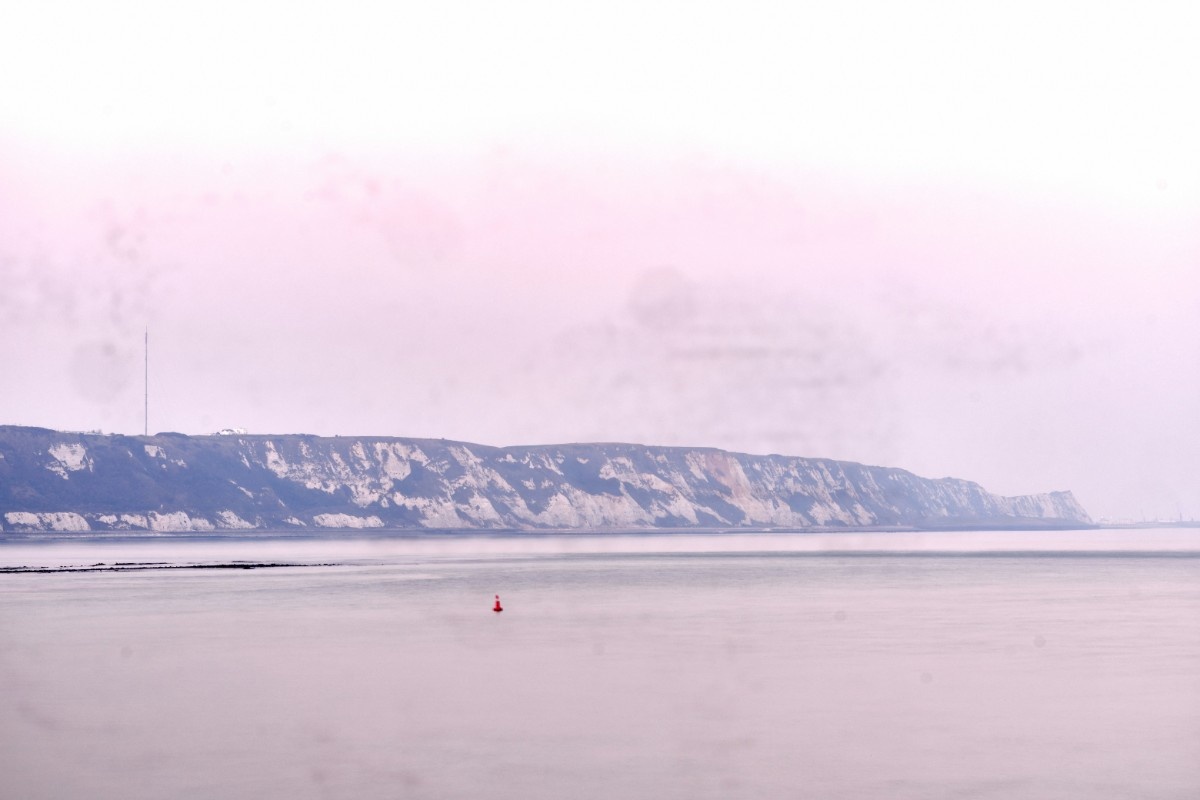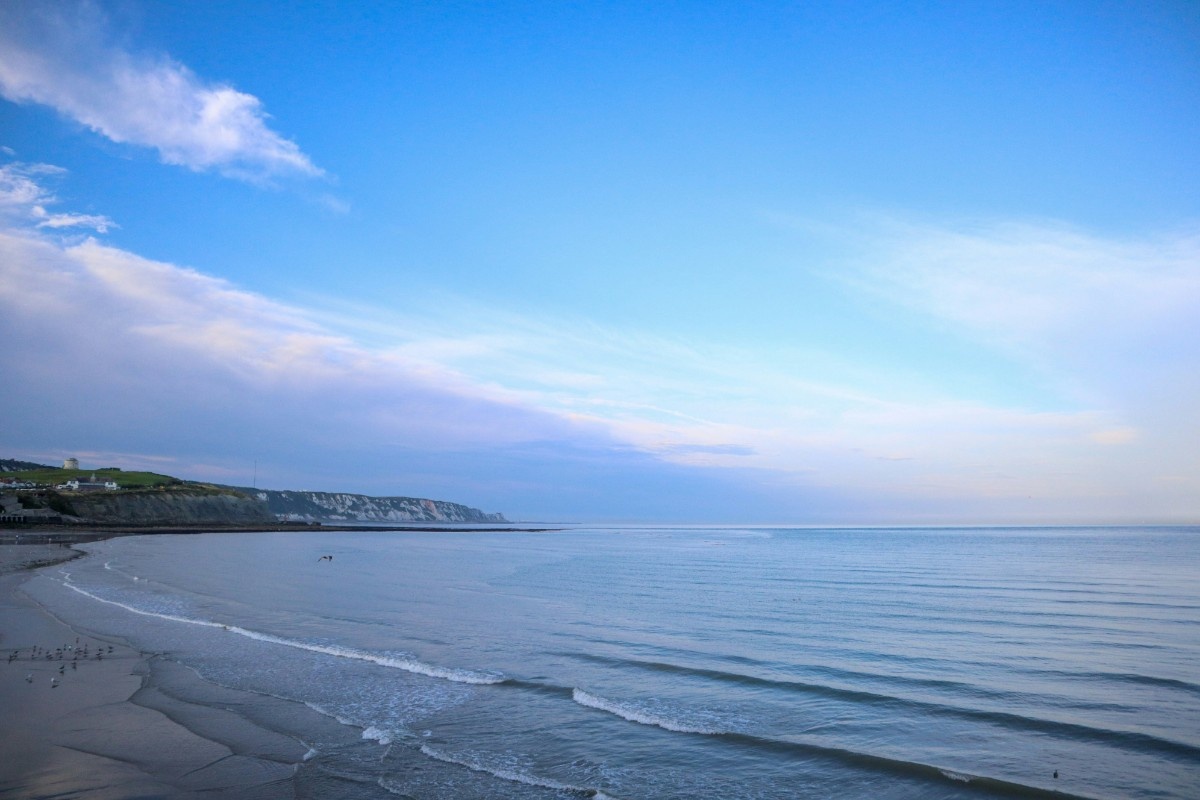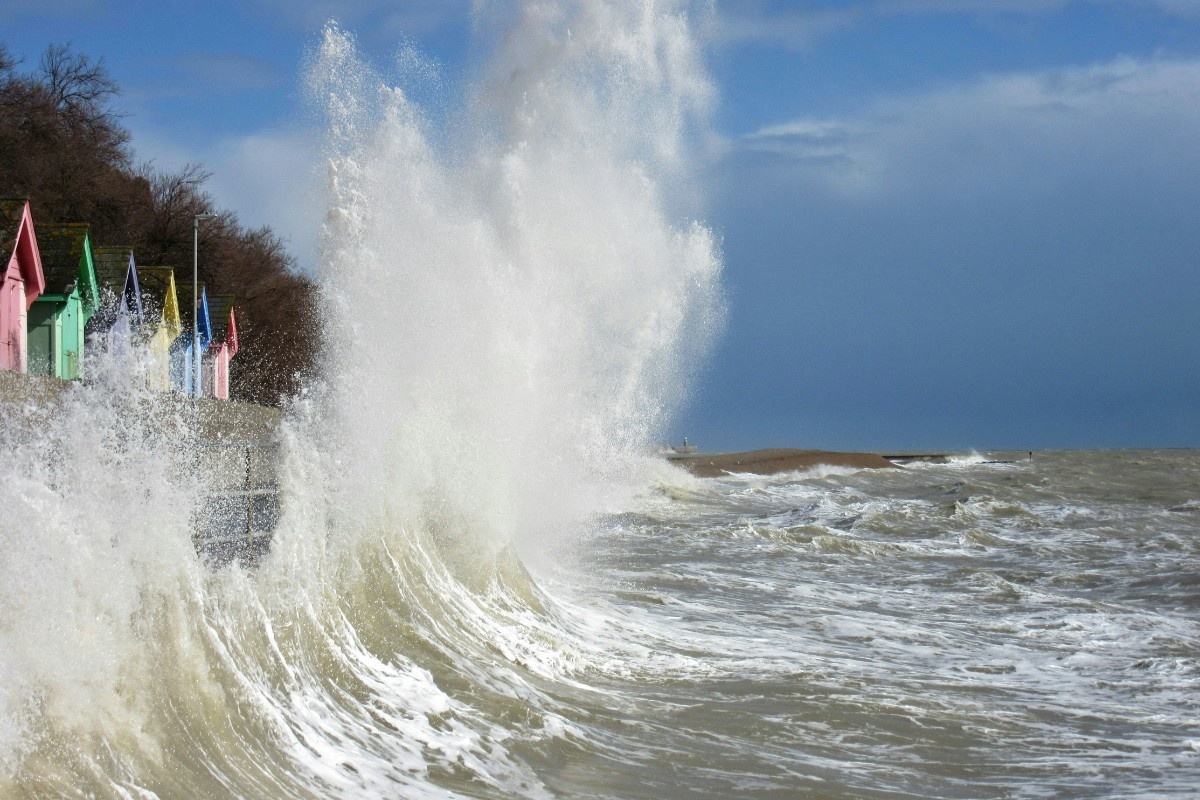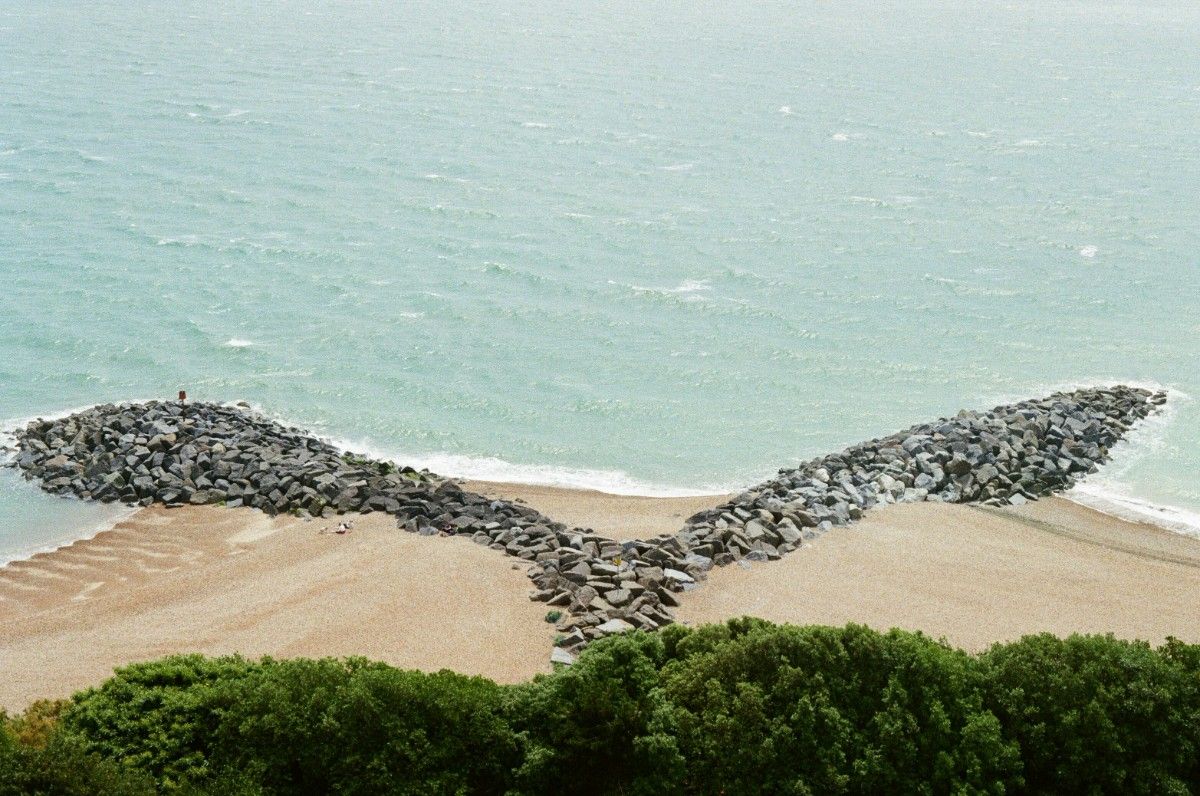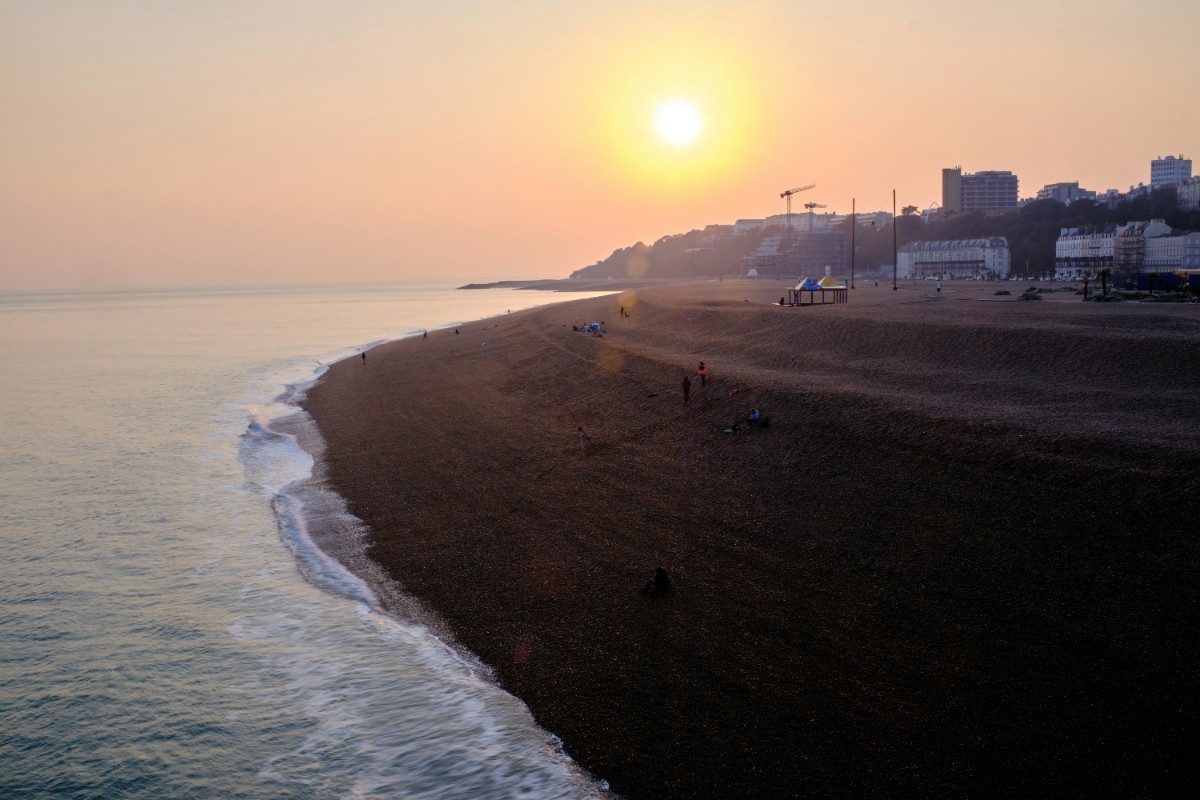The Geography and Geology of Folkestone Beach
Coastal Formation and Cliffs
Folkestone Beach stretches along the southeastern coast of England, facing the English Channel. This picturesque shoreline is an integral part of the Kent coastline, renowned for its diverse landscapes and geological significance. The beach is characterised by its striking chalk cliffs, which form part of the North Downs, a ridge of chalk hills extending from Farnham in Surrey to the White Cliffs of Dover. These cliffs are composed of soft, white limestone that formed during the Cretaceous period, approximately 100 million years ago.
The geological composition of Folkestone Beach offers a fascinating glimpse into the Earth's history. As visitors walk along the shore, they can observe the striking contrast between the white cliffs and the grey pebbles and sand that make up the beach. This juxtaposition is a testament to the complex geological processes that have shaped the area over millions of years.
One of the most intriguing aspects of Folkestone Beach's geology is its abundance of fossilised remains. The area is a treasure trove for palaeontologists and fossil hunters, particularly known for its marine fossils from the Lower Cretaceous period. The Folkestone Formation, a layer of sedimentary rock exposed in the cliffs and foreshore, is exceptionally rich in fossils, including ammonites, bivalves, and various marine reptiles. This makes Folkestone Beach not only a beautiful coastal destination but also an open-air museum of prehistoric life.
Beach Composition and Coastal Processes
The composition of Folkestone Beach is not uniform, reflecting the complex interplay of tides, currents, and sediment transport along the coast. While some areas are predominantly pebbly, others, like Folkestone Sunny Sands Beach, offer stretches of fine sand. This variation adds to the beach's charm and provides diverse environments for both wildlife and beachgoers.
The pebbles found on Folkestone Beach are primarily flint, originating from the erosion of the chalk cliffs. Over time, these flints have been rounded and smoothed by the constant action of the waves, creating a distinctive shoreline texture. The movement of these pebbles along the coast is influenced by longshore drift, a geological process where waves move sediment along the shore. This process tends to transport sediment from west to east along this stretch of coastline.
To counteract erosion and maintain the beach, groynes - wooden or stone structures extending out to sea - have been constructed along the shore. These structures play a crucial role in trapping sediment and preventing it from being washed away, helping to preserve the beach's shape and extent.
The tidal range at Folkestone Beach is significant, with the difference between high and low tide reaching up to 6 metres during spring tides. This large tidal range exposes a considerable area of the beach at low tide, revealing fascinating rock pools and providing excellent opportunities for beachcombing and exploring marine life. The ever-changing tides contribute to the dynamic nature of the beach, constantly reshaping the shoreline and influencing the distribution of sediment.
Climate and Weather Patterns
The climate plays a crucial role in shaping the experience at Folkestone Beach. The area enjoys a temperate maritime climate, characterised by mild temperatures year-round. Summers are generally warm but not hot, with average high temperatures around 21°C in July and August. Winters are cool, with average lows around 3°C in January and February. Rainfall is distributed throughout the year, with October and November typically being the wettest months.
The prevailing winds at Folkestone Beach come from the southwest, bringing mild, moist air from the Atlantic Ocean. These winds can create excellent conditions for water sports such as windsurfing and kitesurfing, particularly in the spring and autumn months. However, during winter storms, strong winds from the east or northeast can create dramatic wave conditions along the beach, showcasing the raw power of the sea.
Understanding the geography and geology of Folkestone Beach enhances appreciation for this unique coastal environment. From the ancient chalk cliffs to the ever-changing shoreline, the beach offers a fascinating glimpse into the geological processes that have shaped the Kent coast over millions of years. Whether visitors are interested in fossil hunting, observing coastal erosion processes, or simply enjoying the diverse landscapes, Folkestone Beach provides a rich tapestry of geological wonders to explore.
The History and Cultural Significance of Folkestone Beach
Ancient Origins and Early Settlements
The history of Folkestone Beach stretches back thousands of years, playing a significant role in the development of the town and the wider region. Archaeological evidence suggests that the area around Folkestone has been inhabited since the Mesolithic period, over 8,000 years ago. The proximity to the sea and the abundance of natural resources made it an attractive location for early human settlements.
During the Roman period, Folkestone was an important site, with a villa complex located near the present-day harbour. The Romans likely used the beach as a landing point for trade and communication with the continent. This early history laid the foundation for Folkestone's long-standing relationship with the sea and its beaches.
In the medieval period, Folkestone developed as a fishing village. Folkestone Beach played a crucial role in the local economy, providing a base for fishing boats and a place to land catches. The town's fishermen were known for their skill in catching herring, and the industry thrived for centuries. Even today, visitors can see remnants of this fishing heritage in the harbour area, where small fishing boats continue to operate.
Victorian Era and the Rise of Seaside Tourism
The 19th century brought significant changes to Folkestone Beach and the surrounding area. The arrival of the railway in 1843 transformed Folkestone from a quiet fishing village into a fashionable seaside resort. The beach became a popular destination for Victorian holidaymakers, who flocked to the town to enjoy the sea air and engage in the latest bathing trends.
During this time, the concept of sea bathing for health became increasingly popular. Folkestone Beach saw the introduction of bathing machines – wheeled changing rooms that could be rolled into the sea, allowing bathers to enter the water with modesty. The beach also became a social hub, with promenades and piers constructed for leisurely strolls and people-watching.
The cultural significance of Folkestone Beach was further enhanced by its association with notable figures in literature and art. The famous author H.G. Wells lived in Folkestone for several years and often wrote about the town and its beach in his works. The renowned artist J.M.W. Turner also visited Folkestone and created several paintings depicting the beach and harbour, cementing its place in British cultural history.
World Wars and Military Significance
Folkestone Beach played a crucial role during both World Wars, adding another layer to its historical significance. In World War I, it served as a major embarkation point for troops heading to the Western Front. Millions of soldiers passed through Folkestone on their way to France, earning the town the nickname "England's Gateway to the Front".
During World War II, the beach was heavily fortified as part of the coastal defences against potential invasion. Remnants of these defences, such as pill boxes, can still be seen along the coastline today, serving as poignant reminders of the beach's strategic importance during times of conflict.
Post-War Era and Modern Cultural Renaissance
In the post-war years, Folkestone Beach continued to be a popular holiday destination, although the nature of seaside tourism was changing. The advent of affordable international travel in the 1960s and 1970s led to a decline in traditional British seaside resorts. However, Folkestone has worked to reinvent itself in recent decades, with the beach playing a central role in this regeneration.
One of the most significant cultural developments in recent years has been the Folkestone Triennial, an art festival that began in 2008. This event has seen numerous artworks installed along the beach and throughout the town, many of which engage directly with the coastal environment. Notable examples include Cornelia Parker's "The Folkestone Mermaid", a sculpture inspired by Copenhagen's famous Little Mermaid statue, which now sits on a rock overlooking the beach.
The beach has also been at the centre of environmental and conservation efforts. In recent years, there has been growing awareness of the need to protect the coastal ecosystem and address issues such as plastic pollution. Community beach cleans and educational programmes have become regular features, highlighting the beach's role in fostering environmental stewardship.
Today, Folkestone Beach continues to be a vital part of the town's identity and economy. It serves not only as a recreational space but also as a living museum of geological and human history. From the fossils in its cliffs to the wartime remnants along its shore, the beach tells the story of Folkestone's evolution from ancient times to the present day.
The cultural significance of Folkestone Beach extends beyond its historical importance. It has become a symbol of the town's resilience and adaptability, weathering economic changes and evolving to meet new challenges. As Folkestone looks to the future, the beach remains at the heart of its identity, continuing to inspire artists, attract visitors, and provide a connection to the natural world for locals and tourists alike.
Exploring Folkestone's Diverse Beaches
Sunny Sands Beach: A Sandy Haven
Folkestone Sunny Sands Beach is perhaps the most popular and well-known of Folkestone's beaches. As its name suggests, this beach is characterised by its fine, golden sand – a rarity along this stretch of the Kent coast, where pebble beaches are more common. Located near the harbour, Sunny Sands Beach is easily accessible and offers a traditional seaside experience. The beach is relatively small but can get quite busy during the summer months, especially on weekends and bank holidays.
Sunny Sands is particularly popular with families due to its safe swimming conditions and the presence of lifeguards during the peak season. The gently sloping beach makes it ideal for paddling and swimming, especially at high tide. When the tide is out, the expansive sandy area provides ample space for building sandcastles, playing beach games, or simply relaxing in the sun.
One of the unique features of Sunny Sands is the annual sandcastle competition held each summer. This event attracts both amateur and professional sand sculptors, who create impressive and often whimsical structures on the beach. The competition has become a beloved local tradition and draws visitors from far and wide, adding to the vibrant atmosphere of this sandy beach in Folkestone.
The proximity of Sunny Sands to the harbour and town centre makes it an ideal spot for those who want to combine beach time with exploring Folkestone's other attractions. After a day on the sand, visitors can easily stroll to nearby cafes, restaurants, and shops, or take a walk along the historic Harbour Arm.
Main Folkestone Beach: A Pebbly Paradise
Moving east from Sunny Sands, you'll find Folkestone's main beach, often referred to simply as Folkestone Beach. This is a long stretch of coastline that extends from the harbour to Sandgate. Unlike Sunny Sands, this beach is predominantly pebbly, with a mix of shingle and larger stones. While it may not be ideal for traditional beach activities like sandcastle building, it offers its own distinct charm and appeal.
The pebble composition of Folkestone Beach creates a unique soundscape as the waves wash over the stones, producing a soothing, rhythmic noise that many find relaxing. Beachcombing is a popular activity here, with visitors often searching for interesting pebbles, sea glass, or even fossils washed up by the tides.
Along this stretch of beach, you'll find the Folkestone Coastal Park, a green space that runs parallel to the shore. This park provides a pleasant area for picnics, walks, and enjoying sea views without being directly on the beach. The park also features several art installations that are part of the Folkestone Artworks collection, a legacy of the Folkestone Triennial.
The main Folkestone Beach is an excellent spot for those who enjoy long walks along the shore. The firm pebble surface provides a good walking terrain, and the extensive stretch of coastline allows for leisurely strolls with beautiful views of the English Channel. On clear days, you can even see the coast of France in the distance.
Mermaid Beach: A Quieter Coastal Retreat
Further along the coast, you'll come to Mermaid Beach Folkestone, named after the nearby Mermaid Cafe. This section of the beach is similar in composition to the main Folkestone Beach, with a mix of pebbles and shingle. It's generally quieter than Sunny Sands or the central part of Folkestone Beach, making it a good option for those seeking a more peaceful seaside experience.
Mermaid Beach is known for its excellent water quality and has consistently received high ratings in environmental assessments. It's a popular spot for sea swimming, especially among locals who enjoy year-round dips. The beach is also favoured by anglers, particularly in the evening when fishing from the shore can be productive.
The area around Mermaid Beach offers a more serene atmosphere compared to the busier sections of Folkestone's coastline. It's an ideal spot for those who want to escape the crowds and enjoy a quieter day by the sea. The beach is backed by cliffs, providing a dramatic backdrop and offering opportunities for coastal walks with stunning views.
Sandgate Beach: The Eastern Boundary
Continuing east, you'll reach Sandgate Beach, which marks the eastern boundary of Folkestone's coastline. Sandgate Beach is another pebble beach, but it tends to be quieter and less developed than the beaches closer to Folkestone town centre. It offers beautiful views across the English Channel and is popular with walkers and dog owners (note that dog restrictions may apply during summer months).
One of the unique features of Sandgate Beach is the Sandgate Sea Cadets centre, which offers sailing and other water-based activities for young people. This adds to the beach's appeal for those interested in water sports and maritime pursuits.
Sandgate Beach provides a more laid-back atmosphere compared to the busier beaches in Folkestone. It's an excellent spot for those who prefer a less crowded beach experience and enjoy the natural beauty of the coastline. The long stretch of pebbles is perfect for leisurely walks, and the area is known for its beautiful sunsets over the Channel.
The diversity of Folkestone's beaches means that there's something for everyone, regardless of your preferred beach activities. From the sandy shores of Sunny Sands to the pebbly expanses of the main Folkestone Beach, Mermaid Beach, and Sandgate Beach, visitors can experience a range of coastal environments within a relatively small area. This variety is one of Folkestone's greatest assets, offering a unique and varied seaside experience that keeps visitors returning year after year.
Activities and Attractions at Folkestone Beach
Water Sports and Swimming
Folkestone Beach offers a wide range of water-based activities for visitors of all ages and skill levels. Swimming is, of course, one of the most popular activities, especially at Folkestone Sunny Sands Beach where the gently sloping shore and sandy bottom make for ideal bathing conditions. During the summer months, lifeguards are on duty at Sunny Sands, providing an extra layer of safety for swimmers.
For those seeking more adventurous pursuits, water sports are a major draw at Folkestone Beach. Kayaking and stand-up paddleboarding are popular activities, with equipment available for hire near the harbour during the summer months. These activities offer a unique perspective on Folkestone's coastline and are suitable for both beginners and experienced paddlers.
Kitesurfing and windsurfing are also possible when conditions are right, typically in the spring and autumn when winds are stronger. The long stretch of Folkestone Beach provides ample space for these exhilarating sports, and the mix of wind and waves can create excellent conditions for experienced riders.
For those who prefer to stay closer to shore, snorkelling is an enjoyable way to explore the marine life around Folkestone Beach. The rocky areas near the beach can provide interesting habitats for various sea creatures, offering a fascinating underwater world to discover.
Fishing and Beachcombing
Fishing is another popular activity along Folkestone's coastline. The beaches and harbour offer good spots for shore fishing, with the chance to catch species like bass, mackerel, and flatfish depending on the season. Anglers can often be seen casting their lines from the beach or the Harbour Arm, particularly in the early morning or evening hours.
Beachcombing is a favourite pastime for many visitors to Folkestone Beach. The pebbly nature of much of the beach means that there's always something interesting to find, from uniquely shaped stones to pieces of sea glass smoothed by the waves. After stormy weather, the beach can be particularly fruitful for beachcombers, with the possibility of finding fossils washed out of the nearby cliffs.
For those interested in marine life and coastal ecosystems, Folkestone Beach offers excellent opportunities for rock pooling. At low tide, especially around the more rocky areas of the beach, numerous rock pools are exposed. These miniature marine worlds are home to a variety of creatures, including crabs, anemones, and small fish. Exploring these rock pools can be a fascinating and educational activity, particularly for children.
Cultural Attractions and Art Installations
One of the unique attractions along Folkestone Beach is the collection of public artworks that form part of the Folkestone Artworks initiative. These permanent installations, many of which resulted from previous Folkestone Triennials, offer an intriguing blend of art and landscape. Notable pieces include Cornelia Parker's "The Folkestone Mermaid" and Tracey Emin's "Baby Things". These artworks not only enhance the visual appeal of the beach but also encourage visitors to engage with the environment in new and thought-provoking ways.
The Folkestone Harbour Arm, a refurbished pier that extends into the English Channel, has become a major attraction in recent years. This vibrant space hosts a variety of food and drink outlets, as well as events and live music during the summer months. It's an excellent spot to enjoy local seafood while taking in panoramic views of the beach and Channel. The Harbour Arm also provides a different perspective on the beach and is a popular spot for photography, especially at sunset.
For history enthusiasts, Folkestone Beach offers a wealth of interest. The area played a significant role in both World Wars, and remnants of this history can still be seen along the coastline. Concrete pill boxes and other defensive structures from World War II can be spotted at various points, serving as poignant reminders of the beach's strategic importance.
Coastal Walks and Nature Observation
For those who enjoy coastal walks, Folkestone Beach serves as an excellent starting point. The beach is part of the Saxon Shore Way, a long-distance footpath that follows the Kent coast. Heading east from Folkestone, walkers can follow the path towards Sandgate and Hythe, enjoying varied coastal scenery along the way. In the other direction, the path leads towards the famous White Cliffs of Dover, offering spectacular cliff-top views.
Nature lovers will find plenty to admire at Folkestone Beach. The cliffs that backdrop the beach are part of the Kent Downs Area of Outstanding Natural Beauty and provide habitats for a variety of plant and animal species. Birdwatching is a popular activity, with species like gulls, cormorants, and occasionally even peregrine falcons spotted along the coast. During the warmer months, butterfly enthusiasts might catch glimpses of species like the Adonis Blue or Chalkhill Blue on the cliff-top grasslands.
Family-Friendly Activities and Events
For families, Folkestone Beach offers a range of child-friendly activities. In addition to traditional beach pastimes like building sandcastles on Sunny Sands, there are often organised events during school holidays. These might include sandcastle competitions, beach sports tournaments, or environmental education activities. The nearby Lower Leas Coastal Park, while not strictly part of the beach, is home to one of the largest free adventure playgrounds in the south east, providing additional entertainment for younger visitors.
Throughout the year, Folkestone Beach hosts various events that add to its appeal. From beach clean-ups that encourage environmental stewardship to outdoor cinema screenings in the summer months, these events help to create a sense of community and bring additional life to the beach.
Whether you're seeking active pursuits, cultural experiences, or simply a place to relax and unwind, Folkestone Beach offers a diverse range of activities and attractions. Its blend of natural beauty, historical significance, and modern amenities makes it a destination that can be enjoyed in many different ways, at any time of the year.
Practical Information for Visiting Folkestone Beach
Transportation and Accessibility
Reaching Folkestone Beach is relatively straightforward, with good transport links to the town. By car, Folkestone is accessible via the M20 motorway, which connects to the M25 around London. The journey from London typically takes around two hours, depending on traffic. If you're using a sat-nav or GPS, the postcode CT20 1QH will guide you to the main beach area.
For those preferring public transport, Folkestone Central railway station is well-connected, with regular services from London St Pancras International (journey time approximately 1 hour on high-speed services). From the station, it's about a 20-minute walk to the beach, or you can take a local bus or taxi.
Once in Folkestone, getting to the beach is easy. The town centre is compact and walkable, with clear signage directing visitors to the seafront. For those with mobility issues, there are local bus services that run to the harbour area, close to Sunny Sands Beach.
Accessibility is an important consideration for some visitors. While Sunny Sands Beach has relatively easy access, some parts of Folkestone Beach can be challenging for those with mobility issues due to the pebble surface. The promenade that runs along much of the beach provides a more accessible route for enjoying the sea views. Several beach wheelchairs are available for hire during the summer months – enquire at the Folkestone Visitor Centre for more information.
Parking and Facilities
Folkestone Beach car parking can be a consideration, especially during peak summer months. There are several car parks near the beach, including the Harbour Car Park (CT20 1QH) and the Lower Sandgate Road Car Park (CT20 1RN). These car parks are pay-and-display, so be sure to have coins or a card for payment. During busy periods, it's advisable to arrive early to secure a spot. Some street parking is also available, but be sure to check signage for any restrictions.
Folkestone Beach car parking options vary in terms of capacity and proximity to the beach. The Harbour Car Park is closest to Sunny Sands and the Harbour Arm, while the Lower Sandgate Road Car Park offers easy access to the main stretch of Folkestone Beach. Prices can vary depending on the season, so it's worth checking the Folkestone & Hythe District Council website for current rates.
In terms of facilities, Folkestone Beach is well-equipped to cater for visitors. Public toilets are available at several locations along the seafront, including near Sunny Sands Beach and along the main promenade. Most are open year-round, but opening hours may be reduced during the winter months.
For those planning to spend the day at the beach, there are numerous cafes, restaurants, and shops in close proximity to the seafront. The Harbour Arm, in particular, offers a variety of food and drink options. However, if you prefer to bring your own food, there are plenty of suitable spots for picnicking, both on the beach itself and in the adjacent Coastal Park.
Beach Safety and Regulations
Beach safety is a crucial consideration when visiting Folkestone Beach. During the summer months (typically May to September), RNLI lifeguards patrol Sunny Sands Beach. However, it's important to note that most of Folkestone's beaches are not lifeguarded, so visitors should exercise caution when entering the water. Pay attention to any warning flags or signs posted on the beach.
The tides at Folkestone Beach can be quite significant, with a large difference between high and low water. It's essential to be aware of tide times, especially if you're planning activities like rock pooling or walking along the shore. Tide tables are usually posted at key points along the beach, and can also be found online or in local information centres.
Dog owners should be aware of restrictions that apply to some of Folkestone's beaches. From 1 May to 30 September, dogs are not permitted on Sunny Sands Beach between 10am and 8pm. However, they are welcome on other parts of Folkestone Beach year-round, as long as they are under control. Always clean up after your dog and dispose of waste in the bins provided.
Weather and Seasonal Considerations
Folkestone Beach weather can be variable, as is typical of the British coast. While summers are generally mild and pleasant, with average high temperatures around 21°C, it's always wise to be prepared for changes in weather. Even on warm days, a breeze from the sea can make it feel cooler, so bringing layers is advisable. In winter, temperatures can drop to around 3°C, but the beach can still be enjoyable for bracing walks if you're properly dressed.
The best time to visit Folkestone Beach depends on your preferences. The summer months (June to August) are the busiest and offer the warmest weather, ideal for sunbathing and swimming. Spring and autumn can be lovely for coastal walks and water sports, with fewer crowds. Winter brings its own charm, with dramatic seascapes and the possibility of storm watching.
For up-to-date information about events, tide times, and local attractions, the Folkestone Visitor Centre, located in Folkestone Harbour, is an excellent resource. Staff there can provide maps, leaflets, and advice to help you make the most of your visit to Folkestone Beach.
Related Articles

Let us know you agree to cookies
We use marketing, analytical and functional cookies as well as similar technologies to give you the best experience. Third parties, including social media platforms, often place tracking cookies on our site to show you personalised adverts outside of our website.
We store your cookie preferences for two years and you can edit your preferences via ‘manage cookies’ or through the cookie policy at the bottom of every page. For more information, please see our cookie policy.
